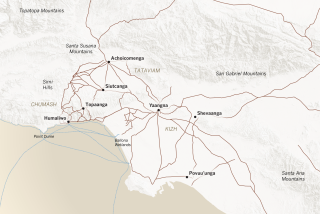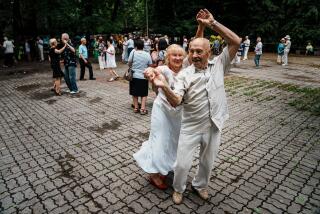American Indian Rituals Attract Tribal Adherents in Russia, Ukraine
KIEV, Ukraine — Broken Hand and his wife, Butterfly, are preparing their feathered headgear and practicing Sioux dances for the “gathering of the tribes” in late June.
The couple, otherwise known as Sergei and Viktoria Tsyganyuk, will leave their apartment in eastern Ukraine, board a Soviet-made train and pitch their tent at the festival--near St. Petersburg, Russia.
The Tsyganyuks are two of about 1,000 people living in Ukraine and Russia who have adopted traditions and lifestyles of various American Indian tribes. Dozens of them gather regularly at remote spots, set up camp and spend days sharing tribal rituals.
Their numbers have mushroomed since the collapse of the Soviet Union at the end of 1991, as people took advantage of newfound intellectual freedom or sought new sources of spiritual solace as economic conditions crumbled.
The Tsyganyuks, who have no known American Indian heritage, say they developed an interest in Lakota Sioux history and rituals in the late 1980s, at the height of glasnost, former Soviet leader Mikhail Gorbachev’s policy of openness.
Viktoria, a schoolteacher, and Sergei, an electrician, have since studied the Sioux language, customs, cuisine, music and religion. They say they correspond regularly with a Sioux family in the United States.
They say “post-Soviet Indians”--as the groups call themselves--get information on Indian life from American Indians who occasionally visit and from books. When one of the “Indians” finds a new text, it is usually shared among many, frequently photocopied.
The Tsyganyuks often meet with a few other “Indians” in their hometown of Kharkiv, near the Russian border.
“We don’t care if they are from enemy tribes,” said Sergei, 34. “We feel a mutual respect for like-minded people.”
The larger gatherings draw people who have immersed themselves in the cultures of tribes such as the Cheyenne, Iroquois, Chippewa, Shawnee and Crow.
Sitting in their cramped apartment in one of Ukraine’s most industrial cities, the Tsyganyuks say their lifestyle emphasizes environmental awareness and a return to purer, closer relations to the Earth.
Yuri Privalov, a sociologist at Kiev’s Institute for Sociology, said such a lifestyle has growing appeal in Ukraine, where industries are atrophying and where the 1986 Chernobyl nuclear disaster still haunts millions.
Privalov, who studies alternative religions, also said their choice is not so surprising in a land where the Orthodox Church is predominant.
“Orthodox Church followers have always placed heavy emphasis on ritual, as do many American Indian tribes,” he said.
The “Indian” groups are not officially registered with local or state governments, said Viktoria Tsyganyuk. “Any formal organization stifles the essence of Indian culture.”
The Tsyganyuks insist they are not looking to convert or recruit other Ukrainians to their way of life.
“It’s a choice of the soul,” she said.
They have introduced their 8-year-old daughter, Katya, to some rituals, but say it will be up to her to decide whether to adopt their lifestyle and attend the gatherings.
Psychologist Yuri Tarabukin, a professor at Kiev’s prestigious Shevchenko University, does not take the “Indian phenomenon” seriously as a social movement.
“They are role-playing. It’s like children putting on their parents’ clothes,” he said.
Some of the appeal may lie with a long-suppressed fascination with America, he added.
A Ukrainian anthropologist who has adopted the name Black Wind said he began modeling his life on the ways of the Cherokee three years ago. Declining to give his legal name, he said some “post-Soviet Indians” have even emigrated to live with tribes in North America.
Among those who remain, he said, is a group of about 50 Russian and Ukrainian “Indians” who recently left for a spiritual journey to the mountains of Russia’s Altai region, and haven’t been heard from since.
More to Read
Sign up for Essential California
The most important California stories and recommendations in your inbox every morning.
You may occasionally receive promotional content from the Los Angeles Times.










